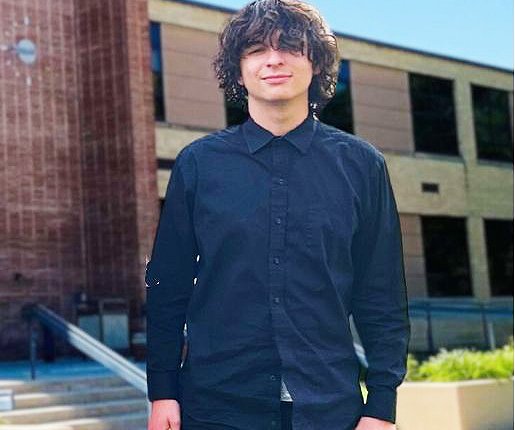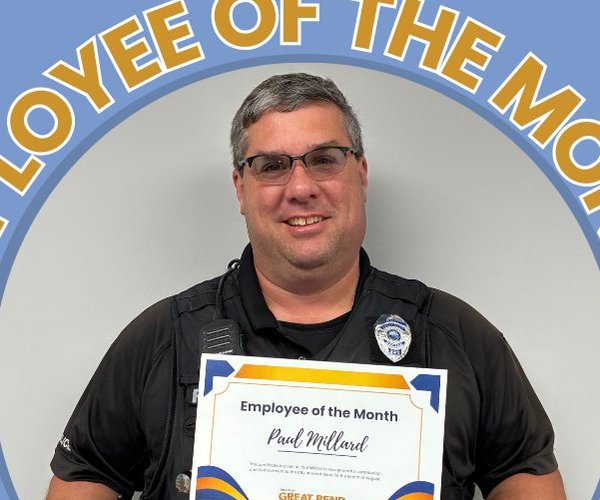USD 428 BOE meeting at a glance
Here is a brief look at what the Great Bend USD 428 Board of Education did Monday evening:
• Unanimously approved a resolution to exceed the Revenue Neutral Rate to finance the 2025-2026 annual budget.
• Following a review of the district needs assessment by Superintendent Kris Thexton, unanimously approved USD 428’s 2025-2026 budget as published Aug. 16.
• The board heard presentations from: Janice Walker, president of Barton County League of Women Voters, on upcuming election and the information app Vote411; Kansas Secondary Educator of the Year Award winner Kim Heath on her activities as speech, debate and forensic instructor at Great Bend High School; GBHS drama instructor Holly Johnson on her plans for the Advanced Theatre students’ trip to Branson, Mo. during the spring break recess in April; and District Maintenance Director Dirk Davis on summer building and grounds preparations for the school year.
• In new business, approved a resolution to adopt the Local Option Budget at 32.3%, which is the statewide average; approved payment of the $9,642 balance due for KASB Worker’s Compensation premium; and reappointed Jacque Disque, board president as delegate to the KASB Delegate Assembly, with Aaron Emerson, vice-president, as alternate.
• In her curriculum and instruction report, Assistant Superintendent JoAnn Blevins updated the board on professional development that included plans for in-service day Oct. 6; reviewed the district’s two-year mentorship program for new and second-year teachers; current curriculum adoption efforts and the district’s efforts to comply with Kansas HB 2382 that took effect July 1 regarding human fetal development presentations required to be included in all courses covering human growth, development or human sexuality appropriate for elementary, middle school and high school students.
• In his business and operations report to the board, Assistant Superintendent John Popp noted that the deadline for updates for required and recommended student immunizations is Oct. 1. To avoid exclusion, one of the following must be submitted to the nurse’s office: Proof of receiving the vaccine; an annual written statement from a licensed physician stating that tests or inoculations would seriously endanger the life or health of the child; or a written, signed statement by parent or guardian that the child is adherent to a religious denomination whose teachings are opposed to such tests or inoculations.
Popp also reminded district students and patrons that good sportsmanship is essential for creating a positive sports environment within the community; and that district policy regarding sporting events should be reviewed and followed.
Popp also gave an update of the District Safety Committee’s targets and goals, with the hope that the monthly meetings can be moved to quarterly sessions.
Popp also advised that district projects needing attention and completion include camera replacement at Park and Riley Elementaries; roofs at Park, the GBHS gymnasium, Riley Elementary partial replacement; and HVAC upgrades to the GBHS gym, auditorium, offices and classrooms and various controls.
• In his report, Superintendent Thexton gave updates on enrollment numbers, the 2025 Kansas Teacher Retention Survey; the 31st annual Kids Ag Day at the Expo Complex; activities of the student organization “Zero Reasons Why” regarding September as Suicide Prevention Month and Suicide Prevention Week as Sept. 7-13; Fire Safety and Awareness Week as Oct. 5-10; and the month’s approval of grants and contributions.
• Meeting minutes and bills and financial reports were unanimously approved in the consent agenda.
The board’s next meeting is at noon Sept. 24, at Great Bend Middle School.
When the state issues a new education mandate, there are liable to be disconnects.
But, as USD 428 Assistant Superintendent JoAnn Blevins explained to the school board during her curriculum report at Monday’s meeting, not like this.
“In the spring, the legislature passed an act requiring school districts to include a human fetal development presentation as a part of any course that addresses human growth, human development or human sexuality,” Blevins explained. “The stipulation in that is that it had to be a 3-minute computer generated animation or high-definition ultrasound that shows the development of the heart, lungs and other vital organs in early human development.”
“That’s all the law stipulates. It doesn’t say anything else. It doesn’t specify age groups, only any time that those three topics are discussed in a course. So we have a small group of district staff members, nurses, administrators, and what we’re working on is identifying all the courses pre-K-12, where those topics are being discussed and then also potential resource materials.“
Blevins was talking about Senate Sub for House Bill 2382, which the Legislature passed by override veto over Gov. Laura Kelly. The law went into effect July 1, covering all 286 school districts in Kansas. The only stipulations were that the video show development of vital organs, be a high-quality, computer-generated animation or high-definition ultrasound,” and that it be three minutes in length.
The bill also allows Kansas State Board of Education members to set their own salaries. An earlier version of the bill set state board member compensation rates at $286.81 per meeting day, which was based on legislative salaries, but the passed bill didn’t designate any funds for raises.
In her veto message, Gov. Kelly said the bill was “convoluted, manipulative and wrong for a number of reasons,” adding “As policy makers and parents, we should demand that our children are provided with high-quality, relevant, researched, and age-appropriate educational experiences free from ideological prejudice. Senate Substitute for House Bill 2382 falls short of that goal.”
The law language did not state specifics on the video’s content, or how to implement its usage, Blevins said. Nor did it offer specifics on timeline, or guidelines for measuring compliance.
“Our challenge, honestly, is the elementary grades,” she said. “First you think of grades 4, 5 and 6 where you have yearly conversations related to puberty and changing bodies, but we also have a new science curriculum so any time human development is taught in science curriculum, this would be a part of that instruction.”
A small group of administrators, educators and nurses has been assembled to begin the task. “What we’re working on right now is which grade levels that would include in the elementary level and then maybe we can start procuring grade-appropriate presentations. At the secondary level, there is more material to choose from. The state department doesn’t advocate curriculum, so a lot of districts are coming up with resource lists and are kind of using that as a group study.”
“We have several nurses that are taking this on. I think at middle school and high school it’s going to be OK, figuring out which resource and then where to plug into those courses.
“Elementary is going to be trickier, to find something that is age appropriate. And as always, with any of these topics, there will be an opt-out for parents who are not comfortable having their students participate or view that presentation.
“That will happen before we present those materials to students. This year will be a separate opt-out, that way we can include the links to the videos and materials so parents can view those as they make that decision. Then, we will include that in the enrollment process of next year going forth, which includes an opt-out for permission for the students to participate.
Right now, it’s a lot of just figuring out the ‘what’ and how it’s supposed to look like,” she said. The group has met once already and plans to meet again on Sept. 19.
Other district
coordination
“It’s a topic right now with curriculum leaders,” she said. “Everybody is finding the same set of videos, we’re all curating that. It’s a matter of everybody looking through their program of studies and identifying the courses. Even if it’s mentioned one time in one lesson, we have to show that. So we have to find that one little bitty lesson in a course so we don’t overlook.
“ We knew it was coming, the curriculum leaders are asking the state department for some guidance on this one. Honestly, what we’ve got wasn’t a lot, because they don’t know, either. We’re building theplane as we go. Nevertheless, we are going to figure out our approach to this, and as that guidance gets revised and changed, we will adjust it. As we do all things,” she noted. “Until the law changes, as it very well could.”





